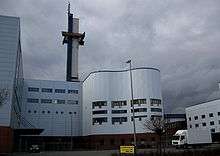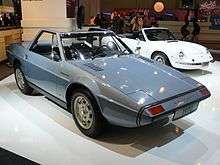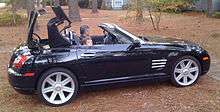Karmann
Coordinates: 52°15′57″N 8°4′40″E / 52.26583°N 8.07778°E
|
| |
|
GmbH - (public limited company) | |
| Industry | Automotive industry |
| Founded | 1901 |
| Defunct | 2010 |
| Headquarters | Osnabrück, Germany |
Number of locations |
Osnabrück, Germany; Rheine, Germany; Bissendorf Germany; São Bernardo do Campo, Brazil |
Area served | Worldwide |
Key people |
Jobst Wellensiek Chairman of the Supervisory Board |
| Products |
convertible automobiles; niche vehicles; convertible roof components |
| Services |
Automotive design; research and development |
| Divisions |
Automotive Global Service GmbH, Osnabrueck; Karmann Engineering-Services GmbH, Bissendorf; Karmann-Rheine GmbH & Co. KG, Rheine; Karmann Rheine – Verwaltungs GmbH, Rheine Karmann-Ghia Żary – Roof Systems, Żary, Poland |
| Website | http://www.karmann.de/ |

Wilhelm Karmann GmbH, known commonly as Karmann, in Osnabrück, Germany, was until 2009 the largest independent motor vehicle manufacturing company in Germany. From 1901 the company fulfilled roles from design to production and assembly of components for various automobile manufacturers; including Chrysler, Porsche and Volkswagen Group.
Origin
The company was established in 1901, when Wilhelm Karmann purchased Klases, a coachbuilder since 1874, and renamed the business.[1] The company then grew together with the expanding automobile industry.[1]
Notable programmes
Widely known cars produced by Karmann include the Volkswagen Beetle Cabriolet (1949–1980) as well as the Volkswagen Karmann Ghia. Between 1955 and 1974, a total of 443,482 VW Karmann Ghias were manufactured, placing their own sports car-style body on the chassis of the Volkswagen Beetle. Subsequently, Karmann assembled the Scirocco, Corrado, and Golf Cabriolet for Volkswagen; the Ford Sierra for the American market (as the Merkur brand by Lincoln/Mercury dealers); and Crossfire coupe and convertible for Chrysler, at the time Daimler-Chrysler. Many Karmann models feature a small wagon wheel emblem, the coat of arms of Osnabrück, where the company was founded.
Karmann assembled complete knock down (CKD) kits in an agreement with American Motors (AMC).[2] In 1968, AMC introduced the Javelin, a new competitor in the U.S. "pony car" segment. AMC did not have a manufacturing subsidiary in Europe, therefore, Karmann assembled the American-designed car for distribution in Europe.[3] Karmann built the cars in Rheine with 280 horsepower (209 kW) 343 cu in (5.6 L) V8 engines.[4] About 90% of the necessary components were shipped by boat from the U.S.[5] All were SST trim versions and their name, Javelin 79-K stood for AMC's "79" model number and the "K" for Karmann.
Karmann is widely known for its work on convertibles/cabriolets, providing roof components for convertibles including the Mercedes-Benz CLK, the Renault Mégane CC, and the Volkswagen New Beetle Cabriolet.
Both the headquarters in Osnabrück and the additional facility in Rheine also construct complete vehicles, such as the former Volkswagen Golf Cabriolet, the former Audi A4 Cabriolet, the Mercedes-Benz CLK, and the Chrysler Crossfire. A small number of vehicles are also produced in Brazil São Bernardo do Campo. The Osnabrück facility also produces the chassis and body panels of the Spyker C8 Spyder.
Other facilities at Sunderland UK, Puebla Mexico, and Plymouth Township U.S. manufacture roof systems for the Nissan Micra C+C, Volkswagen New Beetle Cabriolet, and Pontiac G6, respectively.
A large part of the development of the Chrysler Crossfire was done independently by Karmann, and the vehicle was produced at their Osnabrück facility. Karmann U.S. also supplied the top sub-assemblies for the third-generation Chrysler Sebring (convertible) and Ford Mustang convertible.
Karmann total car production


Since its beginning in 1901, Karmann has built more than three million complete vehicles of the models as follows, exceptions as indicated:
| car make / type | years | number of cars | comments |
|---|---|---|---|
| AMC Javelin 79-K coupé | 1968 | 281 | |
| Audi 80 convertible | 1997–2000 | 12,112 | |
| Audi A4 cabriolet & Audi S4 cabriolet | 2002–2008 | 81,959 | base: end 2004 |
| BMW 2000 C/CS | 1965–1970 | 13,696 | only body in white |
| BMW 3.0 CS | 1971–1975 | 21,147 | |
| BMW 635 CSI | 1976–1989 | 86,314 | |
| Chrysler Crossfire coupé | 2003–2008 | 37,896 | |
| Chrysler Crossfire convertible | 2003–2008 | 16,269 | |
| Ford Escort FEC convertible | 1983–1990 | 104,237 | |
| Ford Escort convertible | 1990–1997 | 80,620 | |
| Ford Escort RS Cosworth | 1992–1996 | 8,082 | |
| Merkur XR4Ti | 1985-1989 | 42,000 | U.S. version of the Ford Sierra XR4i |
| Land Rover Defender | 2002–2005 | 2,777 | in Brazil |
| Mercedes CLK A208 convertible | 1998–2003 | 115,264 | |
| Mercedes CLK C208 coupé | 2000–2002 | 28,706 | |
| Mercedes CLK A209 convertible | 2003–2008 | ||
| Nissan Micra C+C | 2006-2010 | ||
| Porsche 356 | |||
| Porsche 911 | 1966–1971 | 911, 911T, and 911E coupes only | |
| Porsche 912 | 1966–1969 | coupe only | |
| Porsche 914 | 1969–1976 | 118,949 | |
| Porsche 968 | 1991–1994 | 11,803 | only Body in White |
| Renault 19 convertible | 1990–1996 | 29,222 | Body in White and soft tops |
| Renault Mégane I convertible | 1996–2003 | 74,096 | body in white and soft tops |
| Renault Mégane CC | 2004-2010 | only retractable hardtops | |
| Triumph TR6 | 1969–1976 | 94,619 | |
| Volkswagen Beetle convertible | 1949–1980 | 331,847 | |
| Volkswagen Karmann Ghia coupé | 1955–1974 | 362,601 | |
| Volkswagen Karmann Ghia convertible | 1957–1974 | 80,881 | |
| Volkswagen Karmann Ghia Type 34 | 1961–1969 | 42,505 | |
| Volkswagen Golf Mk1 convertible | 1979–1993 | 388,522 | |
| Volkswagen Corrado | 1988–1995 | 97,521 | |
| Volkswagen Golf Mk3 convertible | 1993–1997 | 129,475 | |
| Volkswagen Golf Mk3 Variant | 1997–1999 | 80,928 | |
| Volkswagen Golf Mk4 convertible | 1997–2001 | 82,588 | base Golf Mk3 |
| Volkswagen Scirocco I | 1974–1981 | 504,153 | |
| Volkswagen Scirocco II | 1981–1992 | 291,497 | |
| Volkswagen Tiguan | 2017-2017 | Shifted production of last year of First Generation Tiguan to Osnabrück |
Motorhomes
The first Karmann motorhomes were launched in 1974 based on the Volkswagen Type 2 'Bay Window' chassis. The bodies were of a sandwich structure. These motorhomes had two beds, kitchen, shower, waste water tank, rear body supports, leisure battery, toilet, water heater and gas heating. Options included the luggage rack over the driver's cab. Approximately 1,000 units were produced through 1979.
With the introduction of the Volkswagen T2/3 - also known as the (T3/Vanagon/Transporter/T25) in 1979, the motorhomes received a permanent overhead area with a bed for two people. Called Karmann Gipsy, 741 were made between 1980 and 1992. This number excludes 30 or more Type 3 Syncro models made between 1986 and 1989, and 7 Syncro 16" models made between 1991 and 1992. In addition 113 Cheetah T2/3's were manufactured between 1986 and 1990 to make a total 891 Volkswagen T3 Karmann Coachbuilt Motorhomes - all produced in Karmann Rheine factory and not at Osnabruck as commonly believed.
From 1978 to 1996, a total of 3,103 Volkswagen LT based models were produced. These included the LT "M", LT "L 1", LT "L 2", LT "L Distance Wide", LT "L Distance-Wide Gold", LT "H Distance-Wide", LT "H Distance-Wide Gold", LT "S Distance-Wide" and the top-of-the-line LT "Distance-Wide Autovilla".
In 1991, the Karmann motorhome design was updated and based on the Volkswagen T4. The Gipsy and Cheetah models names were retained in the form of the Gipsy I (SWB) and Cheetah (LWB). In 1996 two new models were introduced namely the Colorado and Missouri. The Volkswagen Transporter (T5) based versions were introduced in 2003.[6]
Production of car modules
- Chassis
- Chrysler Crossfire Coupé 2001–2007
- Chrysler Crossfire Roadster 2003–2007
- Mercedes-Benz SLK
- Spyker C8 Spyder
- Roof modules
- Audi A4 and Audi S4 Cabriolet, 2001
- Bentley Continental GTC convertible, 2006
- BMW 1 Series convertible
- Mercedes CLK convertible
- Nissan Micra C+C retractable hardtop, 2005
- Renault Mégane CC retractable hardtop, 2002
- Volkswagen New Beetle Cabriolet
- Pontiac G6 retractable hardtop, 2007
- Chrysler Sebring retractable hardtop and convertible softtop, 2007
- Ford Mustang convertible, 2007
Bankruptcy
Falling demand along with other financially connected businesses forced the company to file for protective insolvency on 8 April 2009. Insolvency practitioner Ottmar Hermann followed some of the approach seen with the earlier insolvency of Woolworths' German business, and the Karmann business is emerging with little independence, but supported by significant cash investment from long-standing customer Volkswagen.[7][8]
On 8 April 2009, Karmann filed for bankruptcy protection due to the sharp decline in demand for cars, and the company's financial obligations.[9] Volkswagen revealed on 24 October 2009, that it had made an offer to acquire long-time partner Karmann.[10] On 20 November 2009 Volkswagen said that it would buy Karmann's site at Osnabrück, to produce a new vehicle. On 4 November 2010 Valmet Automotive signed an agreement to buy Karmann's roof-component sections in Osnabrück, Germany, and Żary, Poland.[11] Karmann's North American operations were sold August 2010 to Webasto Group.[12]
References
- 1 2 Fisher, Lawrence M. (31 October 1998). "Wilhelm Karmann Jr., 83; Ran German Car Body Maker". The New York Times. Retrieved 2 March 2014.
- ↑ Mitchell, Larry G. (2000). AMC Muscle Cars. MotorBooks/MBI. pp. 43–44. ISBN 978-0-7603-0761-8. Retrieved 2 March 2014.
- ↑ Mederle, Wolfgang A. (18 April 2010). "American Motors - 'Der Karmann Javelin'". American-Motors.de. Retrieved 2 March 2014.
- ↑ "1961 to 1970". Karmann Company History. Karmann.com. Archived from the original on 6 May 2009. Retrieved 2 March 2014.
- ↑ Strohl, Daniel (17 March 2009). "Javeling Through Europe". Hemmings Daily. Retrieved 2 March 2014.
- ↑ The Karmann Coachbuilt Club
- ↑ "Karmann meldet Insolvenz an" (in German). Handelsblatt.com. 8 April 2009. Retrieved 2 March 2014.
- ↑ "Karmann macht sich fit für den Neustart". Osnabrücker Zeitung (in German). 23 January 2010. Archived from the original on 27 January 2010. Retrieved 2 March 2014.
- ↑ Moore, Matt (8 April 2009). "Germany's Karmann Files Bankruptcy". The San Diego Union-Tribune. Associated Ppress. Retrieved 2 March 2014.
- ↑ Elfes, Holger (24 October 2009). "Volkswagen May Take Over Carmaker Karmann, Spiegel Reports". Bloomberg. Retrieved 2 March 2014.
- ↑ "Pontos and Finnish Industry Investment to develop Valmet Automotive with Metso; First step is the acquisition of Karmann´s convertible roof business". wallstreet-online.de. 5 November 2010. Retrieved 2 March 2014.
- ↑ "Webasto Group Takes over Karmann's Convertible Roof Business in North America". Reuters. 5 August 2010. Retrieved 2 March 2014.
External links
| Wikimedia Commons has media related to Karmann vehicles. |